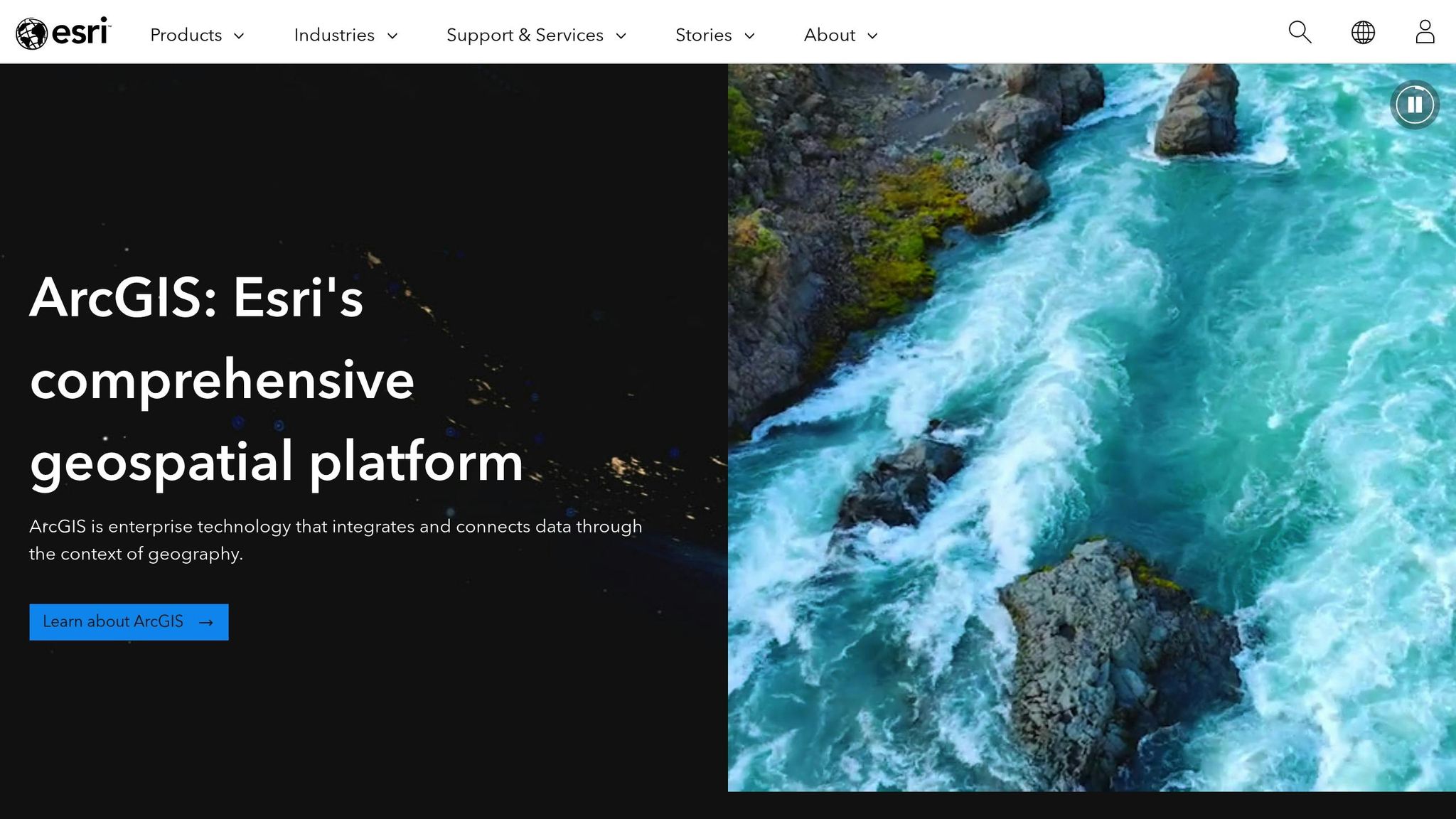Geospatial mapping transforms property data into visual insights, helping real estate professionals make smarter decisions. It combines location information (like addresses or coordinates) with property details (size, value, amenities) to reveal patterns and trends that traditional spreadsheets can’t. Here’s why it matters:
- Understand Market Trends: See how property values change across neighborhoods or regions.
- Evaluate Locations: Analyze proximity to schools, transit, or shopping to assess property value.
- Predict Future Growth: Spot emerging hotspots or areas with untapped potential.
- Streamline Decisions: Investors, developers, and planners can quickly identify opportunities and risks.
Tools like ArcGIS, QGIS, and Google Earth Engine simplify analysis, while data sources like property records, census data, and zoning maps provide the foundation. Services like BatchData ensure accuracy by cleaning and enriching datasets, saving time and improving reliability.
Key Takeaway: Geospatial mapping isn’t just about maps – it’s about turning complex data into actionable insights for better real estate decisions.
Mapping to Millions: Real Estate Riches With GIS Parcel Intelligence | Sponsored by Esri

Data Sources and Tools for Geospatial Mapping
Creating effective geospatial maps hinges on two things: having accurate data and using the right tools. The insights you gain are only as good as the data you start with, and the tools you use can turn that raw information into meaningful, visual intelligence.
Key Data Sources for Property Trend Mapping
When it comes to mapping property trends, a variety of data sources play essential roles:
- Property records: These are the backbone of geospatial property analysis. They include deed transfers, sales histories, assessed values, and ownership details, typically maintained by county assessor offices. Keep in mind, formats and update schedules can vary by location.
- Demographic data: This data adds context to property trends. The U.S. Census Bureau, through the American Community Survey, offers insights into population stats, income levels, age groups, and household compositions. For instance, neighborhoods attracting younger professionals often see a rise in property values and new developments.
- Zoning maps and land use data: These reveal where development is allowed or restricted. Municipal planning departments maintain records showing residential, commercial, industrial, and mixed-use zones. Tracking zoning changes over time can help predict growth patterns and shifts in property values.
- Points of interest (POI) data: Schools, hospitals, public transport stops, shopping centers, and recreational facilities all impact property desirability and pricing. School district boundaries and performance ratings are especially critical for analyzing residential properties.
- Infrastructure data: Information on road networks, utility availability, and planned improvements comes from transportation departments and utility providers. This data helps identify areas with growth potential or development challenges.
- Market transaction data: Multiple Listing Services (MLS) provide real-time insights into pricing trends, days on market, and inventory levels. While accessing MLS data typically requires licensing, it’s invaluable for staying up-to-date on market activity.
These data sources create the foundation for using advanced geospatial tools.
Geospatial Tools and Platforms for Mapping
Choosing the right tools is just as important as having the right data. Here are some of the most commonly used platforms:
- ArcGIS: A leading choice for professional GIS applications, ArcGIS by Esri offers an extensive suite of tools for desktop, web, and mobile. It’s ideal for large-scale property trend analysis, supporting a wide range of data formats and advanced spatial analysis.
- QGIS: This open-source alternative offers many of the same features as ArcGIS, making it a great option for organizations with tight budgets. While it may lack some advanced functionalities, QGIS provides powerful analysis tools and supports standard GIS formats.
- Google Earth Engine: Specializing in satellite imagery and large-scale geospatial computing, this platform is particularly useful for tracking land use changes and analyzing environmental factors that influence property values.
- Tableau and Power BI: These tools combine traditional business intelligence with geospatial capabilities. They’re user-friendly and perfect for those without extensive GIS training, offering mapping features alongside dashboards and reports.
The choice of tools depends on the complexity of your analysis. For simple visualizations, business intelligence tools might suffice, while advanced spatial modeling requires dedicated GIS software.
How BatchData Supports Real Estate Data Enrichment

BatchData simplifies the often time-consuming process of collecting and preparing property data. Instead of manually gathering and standardizing information from multiple sources, real estate professionals can rely on BatchData’s APIs and bulk services for comprehensive property data.
Here’s how BatchData enhances geospatial mapping:
- Data enrichment: Missing addresses are standardized and geocoded, incomplete property details are updated, and contact information is verified for accuracy. Even small errors in location data can lead to misplacements on maps, so precision is critical.
- Custom datasets: BatchData allows users to request tailored data for specific geographic areas, property types, or market segments. This targeted approach reduces processing time and increases the accuracy of analysis.
- Professional services: BatchData offers data pipeline development and integration consulting, helping organizations automate workflows and keep geospatial databases up-to-date. This is especially valuable for ongoing property trend monitoring, ensuring that maps and analyses reflect current market conditions.
BatchData also validates addresses against official postal databases, ensuring spatial accuracy and reliability. By handling the heavy lifting of data preparation, BatchData allows professionals to focus on analysis rather than spending hours cleaning and organizing data. It’s a key partner in any geospatial mapping workflow, saving time and delivering reliable results.
Step-by-Step Guide to Tracking Property Trends with Geospatial Mapping
Now that we’ve discussed the key data sources and tools, let’s dive into the three essential phases for tracking property trends: data collection, preprocessing, and visualization. Each step plays a critical role in turning raw information into actionable insights.
Data Collection and Enrichment
The first step in mapping property trends is gathering comprehensive data. A well-rounded dataset lays the groundwork for understanding market dynamics.
- Property data is at the heart of your analysis. This includes parcel boundaries, full addresses, ownership details, tax assessments, property features (like square footage and lot size), valuations, sales history, and zoning classifications. Most of this information can be sourced from county assessor offices, though it often requires time and effort to compile in a usable format.
- Demographic and psychographic data adds context to your property data. Metrics like population size, median household income, age breakdowns, and socio-economic indicators can explain shifts in local markets. The U.S. Census Bureau’s American Community Survey is a reliable source for this type of information, updated annually for most metro areas.
- Amenity data provides insight into local infrastructure and points of interest. Details about schools, healthcare facilities, public transit, retail hubs, and crime statistics help capture the broader dynamics affecting property values. Municipal planning departments and local government websites are great sources for this data.
For those looking to save time, tools like BatchData automate the enrichment process by pulling complete and standardized property datasets through their APIs. Once your data is collected, the next step is to prepare it for mapping.
Data Preprocessing for Accurate Mapping
Raw data is rarely ready for immediate analysis. Preprocessing ensures your geospatial maps are both accurate and meaningful.
Key preprocessing steps include:
- Standardizing addresses to USPS formats and geocoding them to generate precise latitude and longitude coordinates. This step prevents errors like misplaced properties on your map.
- Normalizing financial figures, such as adjusting historical property prices for inflation using the Consumer Price Index. This ensures consistency when comparing values over time.
- Ensuring consistent units, particularly for measurements, by converting everything to imperial units.
Data validation is another critical step. For example, cross-check property listings for implausible values, or compare sales prices against assessed values to spot inconsistencies. Automated services like BatchData’s address verification tools can streamline this process, cutting processing times from days to just hours, even for large datasets.
Visualizing and Analyzing Property Trends
Once your data is clean and standardized, it’s time to turn numbers into visuals that reveal patterns and trends.
- Heat maps use gradient colors to show property value distributions across geographic areas. For instance, lighter colors might represent lower home prices, while darker shades highlight premium neighborhoods.
- Temporal analysis allows you to track changes over time. By comparing maps from different periods or using animations, you can spot trends like rising property values in areas undergoing development.
- Proximity analysis examines the effect of location on property prices. For example, buffer zones around top-rated schools or transit hubs can highlight areas where proximity drives higher market values.
- Cluster analysis groups properties with similar traits or price trends. This can reveal high-performing neighborhoods or areas attracting buyer interest.
- Multi-layer analysis combines different data types on a single map. By overlaying factors like crime rates, school ratings, and recent sales, you get a fuller picture of what drives a neighborhood’s performance. For instance, areas with low crime, excellent schools, and new infrastructure often show strong market activity.
These visualization techniques make it easier to interpret complex data. Instead of sifting through endless spreadsheets, you can quickly pinpoint emerging markets, identify growth areas, and understand the driving forces behind local property trends.
Key Visualization Techniques for Property Insights
Advanced visualization methods turn geospatial data into engaging visual narratives, helping stakeholders make sense of complex property trends.
Thematic maps are a go-to tool for showcasing property data across geographic areas. They highlight patterns and distributions, while integrated features can track how these trends shift over time. By layering data, thematic maps build on traditional mapping techniques, offering a richer perspective on market dynamics.
Time-series maps take this one step further, adding a temporal dimension. These maps dynamically display how markets evolve, offering a clearer picture of changes over time.
Cluster and Hotspot Analysis
Cluster analysis groups properties with similar traits or market behaviors, uncovering patterns that may not be apparent in raw data. For instance, it can pinpoint neighborhoods with matching price trends, buyer demographics, or market dynamics.
Hotspot analysis digs deeper by using spatial statistics to identify areas where high or low property values are concentrated. Unlike basic clustering, this method determines whether observed patterns are statistically meaningful or just random.
Some practical uses of these techniques include:
- Spotting emerging markets: Hotspot analysis can flag neighborhoods with rapidly rising property values, often before they gain widespread attention.
- Mapping investment opportunities: By identifying clusters of undervalued properties near high-value areas, investors can locate potential growth zones.
- Assessing risks: Cold spots – areas with persistently low values – can signal challenges like low demand or opportunities for revitalization.
When combined with time-series data, these tools become even more powerful, showing how clusters and hotspots shift over time.
Overlaying Multiple Data Layers for Complete Insights
Multi-layer mapping brings together various datasets into a single visualization, offering a well-rounded view of factors that influence property trends. This approach uncovers connections between variables that individual maps might overlook.
Popular layer combinations include:
- Property values + school ratings + crime data: This mix explains why some neighborhoods command higher prices and identifies areas where improvements could drive value.
- Sales activity + zoning changes + infrastructure projects: Overlaying these layers shows how public policies and investments shape market activity.
- Demographic shifts + property appreciation + amenity development: This combination reveals how changing populations influence demand and impact local real estate markets.
Interactive dashboards make multi-layer mapping even more effective. These tools let users toggle layers, adjust transparency, and filter data to focus on what matters most. For example, a real estate investor could explore scenarios by isolating crime data or zoning changes to assess potential risks and opportunities.
The secret to successful multi-layer mapping lies in balance. Start with 2-3 complementary datasets to tell a clear story. Adding too many layers can create visual clutter, while too few might miss key connections. Expand the layers thoughtfully as new insights or specific questions arise.
sbb-itb-8058745
Integrating Geospatial Insights into Business Intelligence Workflows
Geospatial analysis becomes most impactful when it directly supports business decision-making. Beyond creating visually appealing maps, the challenge lies in transforming these spatial insights into strategies that drive measurable business outcomes. For instance, successful real estate professionals don’t stop at crafting detailed visualizations – they build systems that channel geospatial insights into actionable results.
Turning Geospatial Analysis into Business Actions
Geospatial analysis plays a pivotal role in shaping investment strategies. Scoring systems evaluate factors like proximity to transit, school district rankings, crime rates, and comparable sales activity. These analyses guide decisions on asset allocation, targeted marketing, and risk management across portfolios.
For example, real estate investment trusts (REITs) leverage heat maps to highlight market trends and identify areas with high price appreciation potential. By layering demographic data with planned infrastructure projects, they can zero in on regions poised for long-term growth.
Marketing teams use spatial analysis to optimize territory planning. Instead of relying on arbitrary geographic boundaries, they assign agents based on metrics like market activity, average home values, and local conversion rates – resulting in more precise and effective targeting.
When selecting development sites, multi-layered analysis becomes indispensable. By examining zoning maps, utility access, traffic flow, and demographic forecasts, developers can identify locations where favorable conditions align – such as population growth, infrastructure improvements, and zoning updates – making them ideal for new projects.
Risk assessment workflows also benefit from spatial insights. Tools like flood zone mapping, crime trend analysis, and economic tracking help investors steer clear of areas where risks are rising or fundamentals are weakening.
Best Practices for Ongoing Monitoring
To maintain the relevance of geospatial insights, organizations implement regular updates for core datasets, while key indicators like sales activity or inventory levels often require more frequent monitoring.
Alert systems further enhance decision-making by notifying stakeholders of major market shifts – such as inventory spikes, price changes, or new development announcements. These alerts allow businesses to respond quickly in fast-changing markets.
Tracking performance is essential to measure the impact of geospatial insights. Organizations evaluate metrics like forecast accuracy, the success rate of properties chosen using spatial analysis, and the overall returns on their geospatial investments.
Data quality is another critical factor. Regular checks for completeness, outliers, and alignment with market conditions help avoid costly mistakes in investment or development decisions.
Clear reporting schedules ensure that insights reach the right stakeholders. Executive dashboards offer high-level trend summaries, while periodic reports dive deeper into strategic details. Ad-hoc reports address urgent market developments, giving organizations the flexibility to adapt insights to their operational needs.
Using BatchData for Workflow Integration
BatchData simplifies geospatial workflow integration with tools and services designed to keep data accurate and accessible. Through APIs, geospatial platforms can pull BatchData’s up-to-date property and contact data directly, eliminating manual data entry and ensuring mapping tools always reflect current market conditions.
For large-scale projects, BatchData’s bulk data delivery provides comprehensive datasets tailored for metro-wide analyses or extensive market databases. These datasets are formatted for seamless use with popular GIS platforms and business intelligence tools.
BatchData also creates custom datasets to meet specific geospatial needs. By combining property data with external sources, they enable businesses to track niche property types or market segments that align with their strategic goals.
Additionally, BatchData’s professional services help design and implement workflows tailored to specific business objectives. Their consulting covers everything from building data pipelines to integrating geospatial tools with existing business intelligence systems, ensuring a smooth transition from analysis to action.
Conclusion and Key Takeaways
Geospatial mapping takes raw market data and turns it into clear, actionable insights. By transforming complex information into visual strategies, this technology allows professionals to uncover opportunities and risks that traditional methods might overlook. Tools like heat maps and multi-layer analysis help real estate professionals translate these insights into practical business decisions, offering a clearer view of current market dynamics while shaping future strategies.
Highlights of Geospatial Mapping Benefits
One of the standout features of geospatial mapping is its ability to reveal patterns across space and time. Instead of sifting through endless spreadsheets of property addresses and sales numbers, professionals can visualize market trends as they play out across neighborhoods, cities, or even entire regions.
Bringing together diverse data sources is another game-changer. When property records, demographic stats, infrastructure details, and economic indicators are merged into a single visualization, decision-making becomes faster and more informed.
Geospatial tools also refine risk assessment. By layering data like flood zones, crime rates, school districts, and transportation access, professionals gain a full picture of a property’s environment. This multi-dimensional perspective helps avoid costly errors and ensures smarter investments.
Practical Steps for Professionals
To make the most of geospatial mapping, professionals should begin by identifying specific use cases – whether it’s tracking trends for investments, refining marketing territories, or evaluating potential development sites. Success hinges on maintaining high-quality, up-to-date data and integrating these insights into everyday workflows. Automated alerts, scheduled reports, and tailored dashboards can connect geospatial insights directly to business processes, making them actionable.
BatchData’s professional services offer a practical way to integrate spatial analysis into operations. Their APIs enable seamless mapping platform integration, and bulk data delivery supports large-scale analyses across multiple markets.
As the real estate industry increasingly embraces data-driven decision-making, those who adopt geospatial mapping now will gain a competitive edge. This technology not only enhances the ability to spot opportunities and manage risks but also improves client service. The tools are ready, the benefits are clear, and those who act stand to lead in this evolving landscape.
FAQs
How does geospatial mapping help real estate professionals make better decisions?
Geospatial mapping gives real estate professionals a powerful edge by providing detailed, location-specific insights that traditional methods often miss. It’s a game-changer for spotting growth opportunities, evaluating risks, and predicting property value trends with more precision.
By visualizing data patterns and uncovering hidden opportunities, geospatial mapping supports smarter, evidence-based decisions. This means better investments, lower risks, and higher profitability. Its capacity to deliver actionable insights has made it an essential tool in today’s real estate landscape.
What key data sources are needed for geospatial mapping of property trends, and how do they help in the analysis?
Geospatial Mapping of Property Trends
Geospatial mapping of property trends pulls together various data sources to deliver precise and actionable insights. These sources include:
- Satellite imagery: Provides detailed visuals of geographic areas, revealing land use patterns and tracking urban development.
- GIS databases: Helps map and analyze spatial relationships, such as how close properties are to amenities, schools, or transportation hubs.
- Demographic data: Covers factors like population growth and income levels, offering a deeper understanding of the social and economic drivers behind property markets.
- Real estate-specific data: Includes property values, transaction histories, and market trends, which are crucial for tracking performance and spotting opportunities.
By weaving these datasets together, analysts can spot trends, highlight promising investment areas, and make informed decisions. Platforms like BatchData take this a step further by providing tools for data enrichment, integration, and analysis, making it easier to interpret and visualize property trends with clarity.
How can real estate professionals use geospatial mapping to better understand property trends and enhance their business strategies?
Real estate professionals have a powerful tool at their disposal: geospatial mapping. This technology allows them to dive into location-based data, spot market trends, and uncover valuable opportunities for investment or development. It’s all about seeing the bigger picture – literally.
With GIS technology, professionals can visualize patterns that might otherwise go unnoticed. Want to identify a neighborhood primed for growth? Or pinpoint the best site for a new development? Geospatial insights make these tasks not only possible but far more efficient.
To make the most of geospatial tools, it’s important to focus on a few key areas:
- Organizing spatial data: Accurate, well-structured data is the foundation for meaningful insights.
- Integrating location analytics: Embedding these insights into daily workflows can sharpen market analysis.
- Automating tasks: From site selection to trend visualization, automation saves time and boosts productivity.
These strategies do more than just enhance decision-making – they streamline operations, lower risks, and reveal hidden opportunities in the competitive real estate landscape. Platforms like BatchData offer advanced solutions to help professionals seamlessly integrate and enrich their data, making geospatial insights an everyday part of their toolkit.



